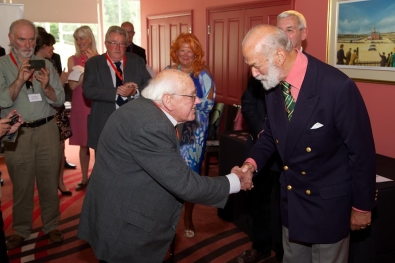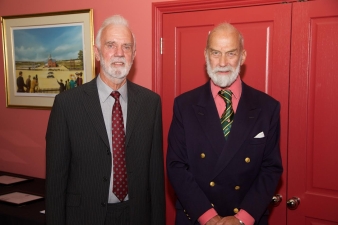The Trust offers financial assistance to individuals or groups to carry through restoration or improvement projects to completion. The Trust also invites enquiries about sponsoring one or more Awards.

Ron Barker
After a career in the aircraft industry Steady Barker, as he has been known almost since he left school, joined the staff of The Autocar magazine almost exactly 60 years ago, and began to combine earning a living with his life-long interest in cars. He had attended race meetings here at Brooklands in the 1930s, and after spending the war servicing Merlin engines for the RAF in India and the Far East he had joined the
Vintage Sports car Club in 1947 when it was relatively young and most of the founding fathers were still around. He went on to edit the Vintage Sports Car Bulletin for three years, introducing the very dry almost whimsical humour for which it and he are so well known.
 After The Autocar where he road-tested all manner of cars, he went on to write for Car Magazine and The Automobile. His style challenged the predominantly technical motoring journalism which had been the norm. He once described a Citroen 2CV which he was testing as “largely constructed of paint, with a thin metal backing” and he would frequently tell his reader as much about what he had had for lunch during the test
After The Autocar where he road-tested all manner of cars, he went on to write for Car Magazine and The Automobile. His style challenged the predominantly technical motoring journalism which had been the norm. He once described a Citroen 2CV which he was testing as “largely constructed of paint, with a thin metal backing” and he would frequently tell his reader as much about what he had had for lunch during the test
as about the car he was testing.
He believed that if you were reviewing a cheap Austin, your review should be of interest to the Rolls Royce driver, and your review of a Rolls Royce should be of interest to the man who would never afford one. He led the way for later motoring journalists such as Jeremy Clarkson and James May and even perhaps Top Gear.
His own collection of cars was impressively large and varied - Bugatti, Cadillac, Peugeot, Renault; Edwardian, vintage, post vintage and modern. His main interest though was in Napier of which he had 3 and Lancia of which he had rather more, and he drove competitively in vintage racing for many years. For five years his everyday car was a 1920 6.25 litre Napier with only rear wheel brakes and I recall an interesting trip with him on the 1908 Napier restored by him which had very respectable acceleration but, again, no front brakes.
He was a very popular VSCC President and is known far and wide in the old car movement as well as being a legend in motoring journalism. He celebrated his 90 th birthday by wing-walking and at 94 he is still very active, still driving, still buying and selling cars, still making awful puns, still writing. Steady Barker
Alan Nightingale
 Alan joined what was to become the Historic Commercial Vehicle Society in 1960 and became assistant treasurer in 1963, then treasurer for 10 years. He was involved in the incorporation of the society and its conversion to a charity.
Alan joined what was to become the Historic Commercial Vehicle Society in 1960 and became assistant treasurer in 1963, then treasurer for 10 years. He was involved in the incorporation of the society and its conversion to a charity.
He has attended all but one Commercial Vehicle London-Brighton Run since 1962, and has even managed to take part in it; but only once, as he was too busy making it happen - as editor of the event programme for ten years, as Chief Marshal at Brighton and a member of the selection committee. Since 1991 he has been one of the two Judges who decide the Outright Concours Winner at Brighton.
After 28 years he tried to escape by moving to Suffolk but stayed out for only two years before being persuaded to rejoin the Society’s Council in 1993. In the absence of other volunteers; he took on the role of Deputy Chairman, then Chairman for 4 years. When a new Chairman took over he was able finally to retire in 2012 and now holds the position of Vice President.
Without people like Alan who are prepared to do the background jobs, to organise and manage, our transport preservation world would not be able to function as it does, and it is for just such circumstances that our Lifetime Achievement Awards were created. Alan is a very worthy recipient.
David Colemore
 Planning consent to build two and a half miles of track was sought in 1981. This was eventually granted in 1994, but in the meantime consent was obtained to restore rather less than a mile of track from Corris to the engine shed at Maespoeth. The first train operated over this section in 1985. In 1996 a significant milestone was achieved when Locomotive No. 4 was loaned to the Corris by the Talyllyn together with some waggons and a brake van. Its return on a demonstration train was a symbol of progress of immense importance, giving promise of a return of steam to the railway. In 2002 permission was granted to carry public passengers. In 2003 the first public train ran and the Talyllyn again showed their support by lending a short passenger train, hauled by former Corris locomotive No. 3.
Planning consent to build two and a half miles of track was sought in 1981. This was eventually granted in 1994, but in the meantime consent was obtained to restore rather less than a mile of track from Corris to the engine shed at Maespoeth. The first train operated over this section in 1985. In 1996 a significant milestone was achieved when Locomotive No. 4 was loaned to the Corris by the Talyllyn together with some waggons and a brake van. Its return on a demonstration train was a symbol of progress of immense importance, giving promise of a return of steam to the railway. In 2002 permission was granted to carry public passengers. In 2003 the first public train ran and the Talyllyn again showed their support by lending a short passenger train, hauled by former Corris locomotive No. 3.
Mike Boyce.
The Harbour Defence Motor Launch 1387, Medusa, was built in Poole in 1943 with a projected operational life of 5 years. The Navy eked this out to 22 years but her final survey in 1965 said it all.
“She requires extensive and expensive repairs and it is recommended that she be placed on the disposal list (scrap) when no longer required. She will deteriorate rapidly when paid off”.
Mike first saw her swinging on a buoy in Devonport Harbour and she had indeed deteriorated. The aft section was flooded, the fore section had suffered a fire and sections of deck ripped up where other vessels had moored against her. With four friends, he bought her. Mike took the role of skipper and remained so for the next 45 years. Medusa was moved to Portland and operated out of there for several years becoming a familiar sight in Alderney and other Channel ports. Time was taking its toll though and there was extensive rot in the bow and superstructure. Mike now became the driving force for saving the vessel and over the next years there were extensive repairs to return the vessel to seagoing condition.
 The 80s saw her move to Portsmouth to be the centre piece of a museum. This did not go ahead but with a new influx of volunteers the vessel was put back to her wartime livery and armed again. She again operated for several years with Mike at the helm but by the early 2000s her seagoing days were over unless something radical was done. The choice was stark; it was out of the water for good and into a museum or a major refit to stay at sea. The second option was chosen but it was a daunting prospect with initial quotes greater than £4m. The Medusa Trust was set up and Mike and co-owners handed the vessel over to the Medusa Trust which, with Mike as a Trustee, leased a derelict shipyard and worked with another charity, The Maritime Workshop, to take on apprentices, and manage the rebuild. Funding came principally from the Heritage Lottery.
The 80s saw her move to Portsmouth to be the centre piece of a museum. This did not go ahead but with a new influx of volunteers the vessel was put back to her wartime livery and armed again. She again operated for several years with Mike at the helm but by the early 2000s her seagoing days were over unless something radical was done. The choice was stark; it was out of the water for good and into a museum or a major refit to stay at sea. The second option was chosen but it was a daunting prospect with initial quotes greater than £4m. The Medusa Trust was set up and Mike and co-owners handed the vessel over to the Medusa Trust which, with Mike as a Trustee, leased a derelict shipyard and worked with another charity, The Maritime Workshop, to take on apprentices, and manage the rebuild. Funding came principally from the Heritage Lottery.
March 2010 saw Medusa back in the water in better condition than when she was first built. In the autumn of that year HRH Princess Royal attended a re-dedication and presented the ship with the first National Historic Fleet ensign. Much work remained to be done but the vessel was complete and seagoing in time to attend the 2012 jubilee Pageant on the Thames.
This was a proud moment for Mike and for the vessel and was the pinnacle of 45 years as skipper. In the spring of 2013 Mike stood down. A ship he had bought as scrap in 1968 is now as good as new with her historical importance recognised and her future assured. Without a lifetime’s dedication by one man, it would not have happened.
Mike Boyce
The National Transport Trust makes loans to groups, associations and individuals at advantageous rates for the restoration of artefacts - whether mobile or part of the infrastructure. Applications must be supported by a simple business plan which demonstrates the financial viability of the project. A sample business plan is available on request from the Treasurer.
The Trust does occasionaly make Awards for schemes which further the preservation movement. Again if you wish further information please contact the Treasurer.